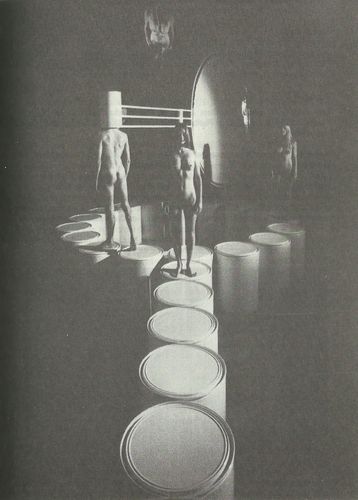Cinemasculpture @ Soon 3/Alan Finneran. 1976

- SOON 3/FINNERAN Alan, Cinemasculpture, directed by Alan Finneran, 1976.
— Tom Di Felice, « Soon 3: An Interview with Alan Finneran », La Mamelle Magazine: Art Contemporary, no.4, Spring 1976, pp.17-19. Include photos. Excerpt:
TD: The progression from painting to Soon 3 is of interest to me. You exercise the same control over a piece as a painter over a canvas.
AF: That’s certainly what gives Soon 3 the character it has – the fact that I come from a visual orientation as opposed to a treatrical background. To make every image, every sound, every piece of sculpture accountable so that it’s not just there. There’s a reason for every motion, for every change in the image so that it will create a natural structure of its own as it happens. Many times people have used this type of input of projections and sound and actors, the use of it being a textural thing creating an overall flowing audio-visual environment. That I see as a major aesthetic difference from the work I do. It’s not my interest at all. At the same time, I don’t want to tell stories with it. I want each piece to create its own existence at the moment its happening. Not at all arbitrary. As you’ve seen, everything is very, very precise. It’s funny because what happens in the show is always extremely clear but why it happens is never clear at all. And that’s intentional. A lot of people have worked the opposite way: what happens is very unclear but why it happens they’ll write you volumes about; the visual information is vague but the literal bullshit behind it will go on for days. I work exactly oppositely in that I make things extremely clear and I don’t even claim to know why they’re happening.
TD: The scale on which you operate seems to put you in a very different position from most other performance artists.
AF: The scale of the work is important because the audience you’re dealing with is so filled and bombarded every day as they drive down freeways, in and out of elevators, and through supermarkets that I think it’s very difficult for people to look at an etching. I have nothing against etchings, but most people would feel more comfortable with my scale of work, because physically it’s in a more naturally relatable state to their environment – a frame in a museum is not a natural part of the environment we all live in. When we set up a show, the feeling, the scale, the simultaneity of its feels like a natural physical presence to exist in for an hour as you watch the show. »
